– The behavior and enrichment practices observed in the video of Chimp Johari playing with a palm frond
– Insights into chimp intelligence and social structures as evidenced by interactions with objects and peers
– The impact of zoo environments on the welfare and behavior of chimpanzees
– Strategies for wildlife conservation and the role of educational programs in fostering a connection between humans and animals.
Observing animals like Chimp Johari playing with a palm frond provides invaluable insights into their cognitive abilities, social habits, and the importance of environmental enrichment for animals in captivity. Chimps are known for their problem-solving skills and use of tools, a trait that places them closer to humans on the evolutionary ladder. Activities such as playing with a palm frond serve as entertainment and stimulate their intellect and physical capabilities, echoing the foraging and nest-building behaviors seen in the wild.
The interaction of Chimp Johari with the palm frond extends beyond mere play. It underscores the complex social structures and communication strategies among chimpanzees. These primates are highly social animals, relying on a sophisticated range of vocalizations, gestures, and facial expressions to communicate. Seeing a chimp engage with objects and peers in a zoo setting offers a glimpse into their world, illustrating the dynamics of dominance, cooperation, and learning within their communities.
Zoos play a critical role in the conservation of species and the education of the public about wildlife. The environment for creatures like Chimp Johari must mimic their natural habitats as closely as possible to promote natural behaviors and ensure their physical and mental well-being. This involves creating spaces that encourage exploration, social interaction, and various activities that prevent boredom and stress, which can manifest in undesirable behaviors. The video of Chimp Johari with a palm frond highlights the effectiveness of enrichment practices designed to enhance the quality of life for animals in captivity.
Wildlife conservation is increasingly critical in today’s rapidly changing environment, with many species facing threats from habitat destruction, climate change, and poaching. Zoos and sanctuaries are on the front lines of conservation efforts, providing safe havens for endangered species and a platform for research and education. By showcasing the amusing and often astonishing behaviors of animals like Chimp Johari, these institutions foster a deeper appreciation and concern for wildlife among visitors. This connection is vital for mobilizing public support for conservation initiatives and promoting behaviors that contribute to preserving natural habitats.
Educational programs centered on animal behavior and conservation play a pivotal role in bridging the gap between humans and the animal kingdom. Through demonstrations, interactive sessions, and engaging content, visitors can learn about wildlife’s challenges and the steps they can take to make a difference. The video of Chimp Johari playing with a palm frond represents more than a moment of amusement; it serves as an educational tool, illustrating the intelligence and adaptability of chimpanzees. Such content can inspire interest in primatology, wildlife conservation, and the ethical considerations of keeping animals in captivity.
In summary, the video of Chimp Johari engaging with a palm frond offers a wealth of educational content related to chimpanzee behavior, zoo management, and conservation efforts. It illuminates the cognitive abilities of these remarkable primates, the complexity of their social interactions, and the vital role that environmental enrichment plays in their well-being. Moreover, it underscores the importance of zoos and sanctuaries in conservation and education, emphasizing the need for ongoing support and involvement in wildlife protection initiatives. Through observation and learning, we can strengthen our connection with the natural world, advocating for policies and practices that ensure the survival and thriving of species like the chimpanzee for generations to come.
*****
Source Description
Chimpanzees are our closest relatives, sharing 98.6 percent of our DNA. Among the many demonstrations of their intelligence, they create tools. Tools are primarily used to obtain food, but they are also used as weapons and in games such as tug of war or catch. Tool use is not instinctive, but rather learned through observation. Different chimpanzee troops pass along different tool-making techniques. Some sharpen sticks like spears to hunt. Others split the ends of sticks to increase the catch of insects per dip.
Unfortunately, these incredible apes are endangered due to poaching, habitat loss, and disease. The L.A. Zoo has supported chimpanzee conservation organizations like Pan African Sanctuary Alliance.
#ApeAwarenessMonth #Chimpanzee #Chimp


